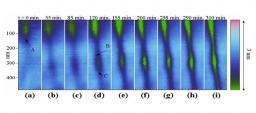 Statistical physics and complex systems
Statistical physics and complex systemsMany situations encountered in daily life are what is called in physics "complex systems": inherently scalable materials such as glasses and polymers, granular materials, chaotic or turbulent fluids, crack propagation in disordered materials and dynamic fracture, but also interacting animals or human in the society ... All these systems have complex collective effects emerging from individual single rules.
Electrical networks with a large number of nodes, also fall into the category of complex systems. They include delocalized production sources and storage devices of intermittent renewable energy and a varying demand, with sometimes contradictory constraints. Nonlinearity questions, intermittent chaos specific to complex systems are then to be taken into account in the development of networks as part of the energy transition.
Understanding these phenomena, especially with statistical and nonlinear physics, is a major issue, for which the complementary experimental and theoretical approaches developed within IRAMIS are a decisive advantage. This complementarity allows deciphering the observed phenomena and brings understanding at the elementary scale (individual, microscopic or atomic) the processes that govern the evolution of the systems.
The understanding and control of the structure, texture, composition, kinetics of evolution of materials and thus of their physical chemical or mechanical properties are a major stake in wide fields. In much cases, the materials which one wishes to use for a given application are intrinsically evolutionary. Out of equilibrium dynamics may affect the mechanic, magnetic or electric properties of a number of materials. In other cases, it is an external action on materials - irradiation, heat treatment, corrosion, mechanical efforts, even sometimes coupling between several of these effects - which puts them out of the equilibrium.
The theoretical and numerical tools of the statistical and nonlinear physics allow an approach of the observed phenomena towards the comprehension of the processes that control this evolution on a microscopic scale.
Understanding the relations between materials microstructure and their mechanical properties is of outmost importance in geophysics and for industrial design. Concerning material failure, the competition between stress enhancement in the vicinity of cracks and disorder in the material microstructure makes it rather complex to predict. However, the tools of out-of-equilibrium statistical physics provide the proper framework to describe crack growth. As for material failure, one seek to relate the rheology of plastic flows in disordered materials like e.g. oxyde glasses and granular matter to the microscopic constituents behaviour through a statistical description.
- Liquides élémentaires
- Liquides complexes (ionique et olymèriques)
- Liquides conditionnés (sous haute pression, confiné, solutions)
- Verres d'oxyde et chalcogenures
- Cristallisation
- Transition vitreuse
Simple liquids - Complex liquids (ionic and polymeric)
- Liquids in special conditions (high pressure, confined, in solutions)
- Oxyde glasses and chalcogenures
- Crystallization
- Glass transition















